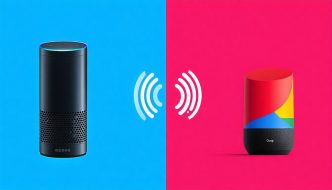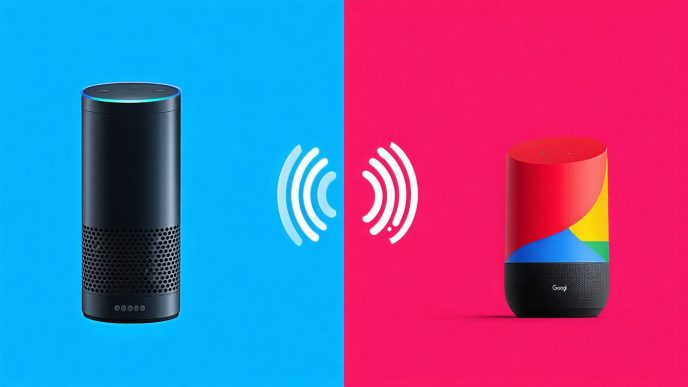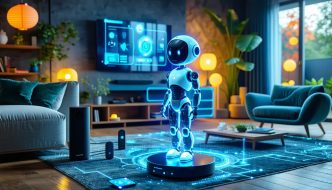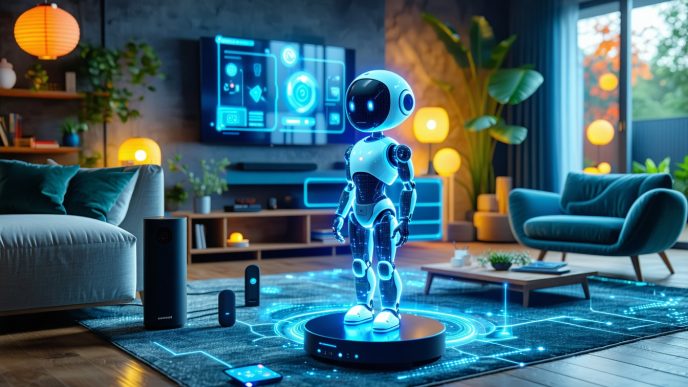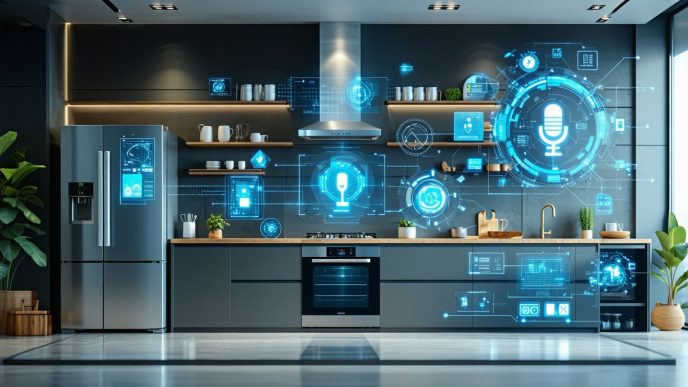The Rise of AI Assistants
Introduction to AI Assistants
AI assistants have emerged as a vital part of modern living, seamlessly integrating technology into everyday tasks. He or she may use AI assistants to control smart home devices, manage schedules, and answer questions. These intelligent programs are designed to simplify interactions with various devices and create a more efficient home environment.
These virtual helpers rely on artificial intelligence and machine learning algorithms to perform tasks that make daily routines easier. They can respond to voice commands or automated triggers, allowing users to interact in a natural, intuitive way. A growing number of families and tech enthusiasts are adopting these innovative tools for their convenience and functionality, which is transforming how homes operate. For a deeper understanding of the role these assistants play, check out the article on ai assistants and smart homes.
Evolution of Home Automation
The concept of home automation dates back several decades, but its evolution has been accelerated by advancements in technology. Initially, home automation systems were complex and required professional installation. As technology progressed, smart devices became more accessible and user-friendly, making it easier for individuals to automate their homes and integrate various systems.
The introduction of AI assistants marked a significant milestone in this evolution. They transformed home automation from merely a convenience into a centralized command system that simplifies control over multiple devices. Below is a brief timeline showing key developments in home automation and AI:
| Year | Development |
|---|---|
| 1960s | Introduction of programmable devices |
| 1980s | First home automation systems for controlling lighting and appliances |
| 2000s | Development of Wi-Fi enabled smart devices |
| 2010s | Launch of AI assistants such as voice-enabled systems |
| 2020s | Expansion of AI assistants into appliances and security systems |
The rising popularity of AI assistants has made them central to the home automation experience. They provide a unified approach to managing technologies, creating a more cohesive interaction for users. To explore specific applications of AI assistants, such as in smart appliances or elderly support, refer to our articles on ai assistants in appliances and ai assistants for elderly support.
Types of AI Assistants
AI assistants come in various forms, each designed to enhance the convenience and functionality of smart homes. Understanding the different types can help users find the best fit for their needs and preferences.
Voice-Controlled AI Assistants
Voice-controlled AI assistants are among the most popular and widely used types. These assistants rely on speech recognition technology and allow users to interact using voice commands. This hands-free operation is ideal for multitasking, making them a favorite among busy individuals and families.
Common functionalities include setting reminders, controlling smart home devices, playing music, and providing weather updates. Some examples of voice-powered assistants can be explored in detail in our article on voice powered robots.
| Feature | Description |
|---|---|
| Trigger Method | Voice commands |
| Primary Use Cases | Home automation, information access |
| Compatibility | Integrates with various smart devices |
Interactive Display AI Assistants
Interactive display AI assistants combine visual interfaces with voice recognition, providing users with a more engaging experience. These devices feature screens that display information visually, making it easier to follow recipes, watch videos, or view schedules.
Interactive display assistants often include touch capabilities, allowing for direct manual interaction. Their multifunctional nature caters to tech-savvy families, making them suitable for activities such as video calls and managing home tasks visually. For insights on how these assistants can interact within smart homes, refer to our article on ai assistants and smart homes.
| Feature | Description |
|---|---|
| Trigger Method | Voice and touch controls |
| Primary Use Cases | Visual information display, multimedia |
| Compatibility | Works with various smart devices |
Robotic AI Assistants
Robotic AI assistants represent a significant innovation in home automation. These robotic devices perform physical tasks, often utilizing navigation technology to move around the house. Common applications include vacuuming, lawn mowing, and even delivering items within the home.
Robotic assistants enhance efficiency and can significantly reduce the time spent on mundane chores. Their autonomous capabilities make them particularly appealing for families seeking more convenience in everyday life. For further exploration of specific use cases, check our article on ai assistant use cases.
| Feature | Description |
|---|---|
| Trigger Method | Autonomous operation |
| Primary Use Cases | Household chores, delivery tasks |
| Compatibility | Limited integration with smart systems |
Each type of AI assistant offers unique advantages and functionalities, catering to diverse needs and enhancing smart home experiences. Understanding these different assistants allows users to make informed choices about which type best aligns with their lifestyle and home environment.
How AI Assistants Transform Homes
AI assistants are revolutionizing the way people interact with their home environments. They offer a wide array of features that enhance convenience, provide personalized assistance, and bolster home security.
Smart Home Integration
AI assistants play a vital role in the integration of smart home devices. They serve as centralized control hubs, allowing users to manage various devices through voice commands or mobile applications. Smart bulbs, thermostats, and smart locks can all be connected to AI assistants for streamlined operation.
| Device Type | Example Features |
|---|---|
| Smart Lights | Adjust brightness and color |
| Smart Thermostats | Set schedules and control temperatures |
| Smart Locks | Secure doors and monitor access |
Integrating AI assistants with smart home technology simplifies daily routines and promotes energy efficiency. Users can easily customize their environments to fit their preferences and lifestyle. More details can be found in our article on ai assistants and smart homes.
Personalized Assistance
One of the standout features of AI assistants is their ability to provide personalized support. By learning user habits and preferences over time, these assistants can tailor their responses and suggestions.
For instance, an AI assistant can create reminders, manage calendars, and suggest recipes based on dietary preferences. This capability enhances organization and improves overall productivity.
| Feature | Customization Potential |
|---|---|
| Daily Reminders | Set based on user-defined schedules |
| Recipe Suggestions | Tailored to favorite cuisines |
| News Updates | Curated according to interests |
Personalized assistance makes daily tasks easier and more efficient. Users can take advantage of the full range of services offered by their AI assistants. Explore more use cases in our article on ai assistant use cases.
Home Security Features
Home security is a major concern for many homeowners. AI assistants enhance security measures by offering features that help monitor and protect the home environment.
Smart cameras, doorbells, and alarms can be integrated with AI assistants, enabling real-time alerts and monitoring through these smart networks. For example, users can receive notifications when someone approaches their front door or can view live footage from security cameras using voice commands.
| Security Feature | Benefits |
|---|---|
| Smart Cameras | Monitor home surroundings |
| Motion Sensors | Detect unusual activity |
| Smart Door Locks | Secure entrances remotely |
These capabilities not only improve safety but also provide peace of mind for homeowners. Learn more about privacy concerns related to AI assistants in our article on privacy and ai assistants.
AI assistants are changing how homes operate, making daily tasks more manageable and environments more secure. Through smart integrations and personalized support, they enhance the overall quality of life for users.
Interacting with AI Assistants
AI assistants have revolutionized the way individuals interact with their technology at home. The methods of interaction are diverse, making it easy for users to engage with their assistants in a manner that is most comfortable for them. This section explores the key ways users can interact with AI assistants: voice commands, gestures and touch controls, and automation routines.
Voice Commands
Voice commands are one of the primary methods for engaging with AI assistants. Users can complete tasks simply by speaking, making interactions intuitive and hands-free. This feature is particularly beneficial in busy households or for individuals with mobility limitations.
| Function | Example Voice Command |
|---|---|
| Playing Music | “Play my evening playlist.” |
| Setting Reminders | “Remind me to take out the trash at 7 PM.” |
| Checking Weather | “What’s the weather like today?” |
Voice recognition technology has advanced significantly, allowing for accurate understanding of commands. Users can also explore various commands and functionalities by voice; for instance, making a comparison between Alexa vs Google Assistant can help them choose the right tool for their needs.
Gestures and Touch Controls
In addition to voice commands, many AI assistants offer gesture and touch controls. This can include swiping or tapping on touch screens for interactive display AI assistants. For users who prefer more tactile interaction or when noise levels need to be minimized, these options provide flexibility.
| Gesture | Action |
|---|---|
| Swiping Left/Right | Navigate through options or apps |
| Tapping the Screen | Select an app or feature |
| Pinching to Zoom | Zoom in or out on maps or photos |
These physical interactions demonstrate the versatility of AI assistants, making it possible to control them through various methods. Gestures and touch controls can also enhance the user experience with home devices equipped with AI assistants in appliances.
Automation Routines
Automation routines allow AI assistants to perform a series of actions with a single command. Users can set up customized routines for daily tasks, creating a seamless interaction with their smart home environment. For example, a morning routine might involve turning on the lights, brewing coffee, and reading the latest news.
| Routine | Associated Actions |
|---|---|
| Morning Routine | Turn on lights, start coffee maker, play news |
| Movie Night | Dim lights, lower shades, turn on entertainment system |
| Bedtime Routine | Turn off all lights, lock doors, set alarm |
Setting up these automation routines can significantly enhance convenience, making life simpler for tech-savvy families. Users can learn more about various use cases for these systems in articles such as ai assistant use cases.
With these interaction methods—voice commands, gestures and touch controls, and automation routines—AI assistants are designed to accommodate a wide range of needs, making them an integral part of modern smart homes. Whether for busy families or individuals seeking convenience, these technologies are poised to reshape home interactions.
Advantages of AI Assistants
AI assistants are quickly becoming essential tools in modern households. They offer various advantages that enhance convenience, improve task management, and ensure accessibility for users.
Convenience and Efficiency
AI assistants streamline daily routines by allowing users to control multiple tasks and devices through simple voice commands or touch controls. This capability reduces the need for manual intervention, which can often be time-consuming. Users can easily manage their schedules, set reminders, and even control smart devices within their homes, boosting overall efficiency.
The following table illustrates common tasks that can be managed by AI assistants:
| Task | Voice Command Example |
|---|---|
| Setting an alarm | “Set an alarm for 7 AM.” |
| Playing music | “Play my favorite playlist.” |
| Adjusting thermostat | “Set the temperature to 72 degrees.” |
For more on managing tasks through voice capabilities, check the article on voice powered robots.
Improved Task Management
AI assistants excel in helping users manage their tasks effectively. They can integrate calendars, send notifications, and help organize activities. By providing reminders and alerts, AI assistants help keep users on track with deadlines and important events.
The integration of AI technology in home environments allows for better coordination among family members or housemates. Users can quickly share grocery lists, appointments, or daily tasks via their AI assistants.
Here are some features related to task management:
| Feature | Description |
|---|---|
| Shared Calendars | Sync calendars for all household members. |
| Grocery Lists | Create and update lists via voice commands. |
| Task Reminders | Set reminders for specific tasks and appointments. |
To explore more examples of how AI can optimize household tasks, visit ai assistant use cases.
Accessibility Features
AI assistants provide crucial support for individuals with disabilities, enhancing their independence. With voice recognition and control, users can operate home systems without needing physical interaction. This includes controlling lights, appliances, and security systems.
AI assistants also offer useful features tailored for the elderly and children. Smart reminders help them manage medication schedules, while interactive interfaces can engage younger users in educational activities.
The following table showcases some accessibility features of AI assistants:
| Feature | Benefit |
|---|---|
| Voice Activation | Enables hands-free operation for users with mobility issues. |
| Customizable Voice Feedback | Adjusts interaction levels to suit the user’s needs. |
| Integration with Assistive Devices | Works seamlessly with devices designed for special needs. |
For additional insights on AI assistants aiding different demographics, refer to ai assistants for elderly support and ai assistants and kids.
By leveraging these advantages, AI assistants transform everyday living, making homes more efficient and accessible for everyone.
Privacy and Security Concerns
As AI assistants become more integrated into everyday life, considerations around privacy and security are increasingly important. Understanding how data is collected, potential vulnerabilities, and best practices for secure usage is essential for users to maximize benefits while minimizing risks.
Data Collection and Privacy Policies
AI assistants rely on data to personalize experiences and improve functionality. This data often includes user interactions, preferences, and even voice recordings. Many companies implement privacy policies that outline how this data is used, stored, and protected.
Users should familiarize themselves with these policies to understand how their information is handled. Common types of data typically collected include:
| Type of Data | Purpose |
|---|---|
| Voice Commands | To improve recognition and response accuracy |
| Usage Patterns | To enhance personalization features |
| Location Data | To provide location-based services |
For insights into how privacy is managed specifically, users can refer to articles on privacy and AI assistants.
Security Risks and Vulnerabilities
With any technology, there are potential security risks. AI assistants may be vulnerable to unauthorized access, hacking, or malware attacks. A breach could lead to sensitive data being exposed or misused. Some common vulnerabilities include:
| Risk | Description |
|---|---|
| Unauthorized Access | External parties gaining control of the AI assistant |
| Data Breaches | Exposure of personal information due to inadequate security measures |
| Eavesdropping | Potential for hackers to listen in on conversations |
By remaining aware of these risks, users can better protect themselves. Regular software updates and applying settings to enhance security can mitigate some vulnerabilities.
Best Practices for Secure Usage
To fully enjoy the benefits of AI assistants while ensuring privacy and security, users should follow certain best practices:
- Use Strong Passwords: Always create unique and complex passwords for accounts associated with AI assistants.
- Enable Two-Factor Authentication: Utilize two-factor authentication where available to add an extra layer of security.
- Regularly Review Privacy Settings: Users should periodically check and adjust privacy settings on their AI assistants for optimal protection.
- Be Cautious with Connectivity: Limit the connection of AI assistants to other devices and services to minimize data sharing.
- Stay Informed: Keep updated about security releases and privacy policy changes related to AI assistants, as these can impact security features.
Understanding the privacy and security aspects of AI assistants is crucial for users who are embracing these technologies for convenience and efficiency in their smart homes. Exploring further on issues like ai assistants and smart homes or how these systems function in various contexts could provide deeper insights into responsible and secure usage.
Future Trends in AI Assistants
The landscape of AI assistants is rapidly evolving, influenced by advances in technology and the growing demand for smart home solutions. Several key trends are expected to shape the future of AI assistants, enhancing their capabilities and integrating them further into everyday life.
Enhanced Artificial Intelligence Capabilities
As AI technology advances, so too will the capabilities of digital assistants. Future AI assistants are expected to become smarter, learning user preferences more efficiently. This will enable them to provide more personalized recommendations and respond to complex queries with greater accuracy. Machine learning algorithms will enhance their ability to adapt to user behavior over time, resulting in a seamless interaction experience.
| Feature | Current Capability | Future Projection |
|---|---|---|
| Voice Recognition | Understands basic commands | Contextual understanding of conversations |
| Task Management | Simple reminders | Advanced scheduling and priority setting |
| Personalized Responses | Limited customization | Highly adaptive suggestions based on user habits |
Integration with IoT Devices
The integration of AI assistants with Internet of Things (IoT) devices will further expand their functionalities. As smart home technology continues to grow, AI assistants will be crucial in managing interconnected devices. This integration will allow users to control everything from lighting and thermostats to security systems with simple voice commands or automated routines.
| IoT Device Category | Current Use | Future Use |
|---|---|---|
| Lighting | Voice control of bulbs | Intelligent lighting preferences based on mood |
| Security | Camera alerts and access | Automated security responses and real-time monitoring |
| Appliances | Basic operation commands | Complex cooking instructions and energy management |
Potential Impact on Daily Life
The advancements and integration of AI assistants into daily routines will significantly enhance convenience for users. These technologies promise to streamline household tasks, improve communication, and increase overall efficiency in managing one’s home environment. Furthermore, AI assistants will increasingly play essential roles in supporting various demographics, including seniors and children, making them valuable tools in everyday life.
For a closer look at specific applications of AI assistants, consider the different AI assistant use cases that can enhance the lives of various user groups, including AI assistants for elderly support and families with AI assistants and kids. As AI technology continues to progress, the possibilities for integrating these assistants into modern living will only expand.








